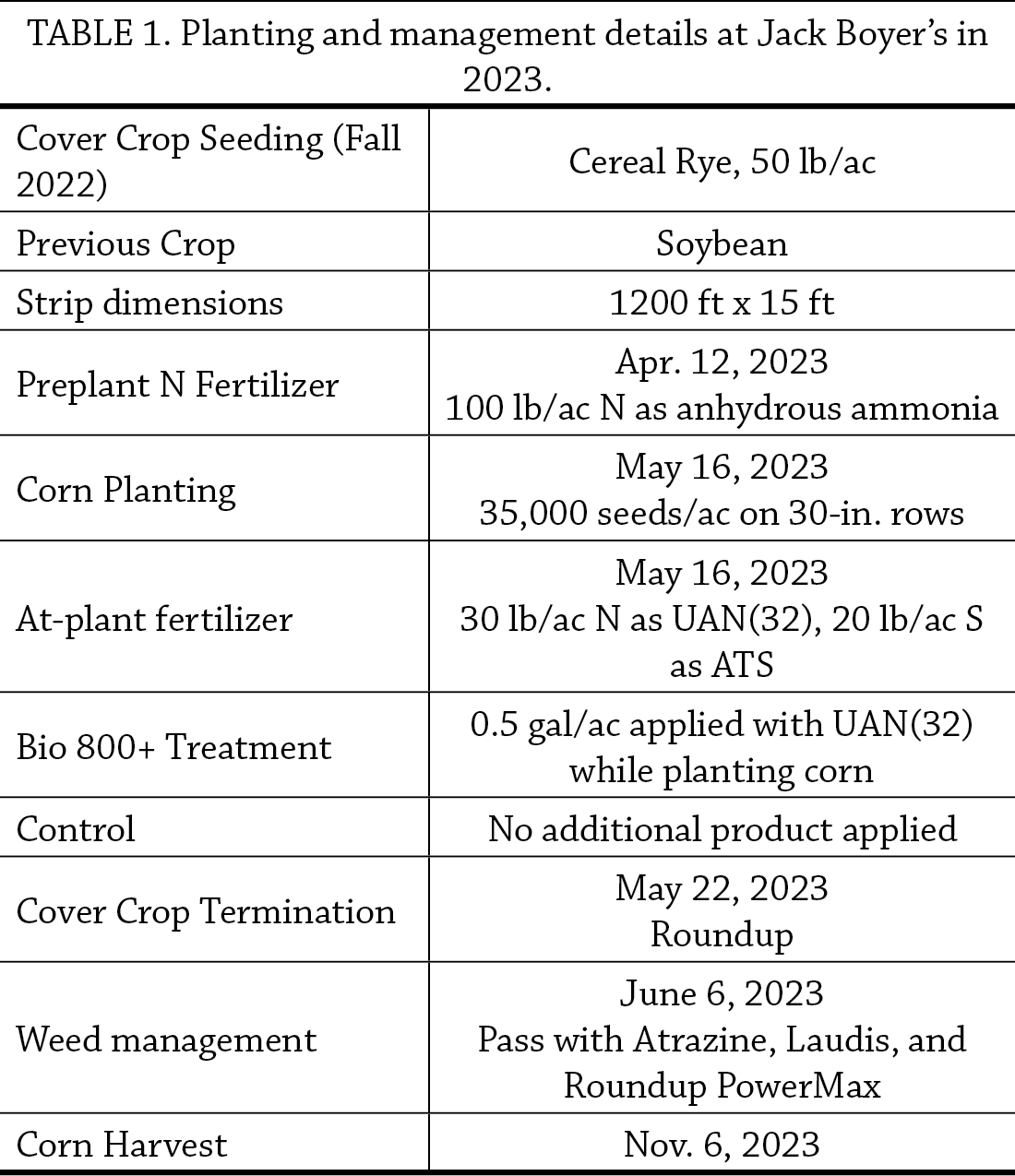PFI Cooperators including Jack Boyer have a long history of testing biological products that are marketed to complement or partially replace regular fertilizer and/or pest management programs. These products frequently claim to boost crop yields, improve soil health, and enhance ecosystem services like nutrient cycling, but most research from PFI and other on-farm and academic researchers has shown that these types of products likely do not affect yield. Boyer investigated the yield impact of applying Holganix Bio 800+, a commercial compost tea, at corn planting in addition to his regular corn fertilizer treatment.
Key Findings
Holganix Bio 800+ did not affect corn yield and cost an extra $20/ac to apply compared to Boyer’s standard nutrient program.
Background
Holganix Bio 800+ is a commercial compost tea marketed as containing hundreds of different genera and species of soil microbes that can promote plant growth and enhance soil ecosystem processes such as breaking down organic matter, cycling nutrients, and fixing nitrogen. Compost tea is water that has been steeped with compost and contains soluble nutrients from the compost. While it has historically been used as a fertilizer with high recommended application rates to add significant nutrients to the soil, in recent years compost tea products including Holganix Bio 800+ have been marketed for use as soil biological amendments. These products have much smaller recommended application rates and are intended solely to add soil microbes to boost plant yield, soil health, nutrient cycling, and other soil functions.
Jack Boyer wished to determine the effect of applying Holganix Bio 800+ at Holganix recommended rates on corn yield and economic performance. Boyer is motivated because “if successful, [Holganix Bio 800+] could have a significant effect on commercial fertilizer usage. This has the potential to have a positive effect on the environment and financial position of [our] farm.” He investigated corn yield under the following treatments: 1) apply Bio 800+ compost tea in furrow with urea ammonium nitrate (UAN) while planting corn; and 2) control, no product applied in addition to UAN while planting corn.

Corn plant roots pulled from Jack Boyer’s trial field in July. Corn from control treatment on the left, Holganix Bio 800+ treatment on the right.
Methods
Design
Boyer established treatments in paired strips with four replications of each treatment for a total of eight strips. Example experimental design is shown in Figure A1 and management practices are shown in Table 1.

Measurements
Boyer recorded grain yield and moisture from each strip using a yield monitor. Yield was standardized to 15.5% moisture.
Data analysis
To evaluate effects of Holganix Bio 800+ on corn yield, we calculated treatment averages for each measurement then used a t-test to compute the least significant difference (LSD) at the 90% confidence level. The difference between each treatment’s average soybean yield is compared with the LSD. A difference greater than or equal to the LSD indicates the presence of a statistically significant treatment effect, meaning one treatment outperformed the other and the farmer can expect the same results to occur 90 out of 100 times under the same conditions. A difference smaller than the LSD indicates the difference is not statistically significant and the treatment had no effect. We could make these statistical calculations because Boyer’s experimental design involved randomization and replication of the treatments (Figure A1).
Results and Discussion

There were no significant differences in corn yield between Boyer’s Holganix Bio 800+ and control treatments (Table 2). The product cost $40/gallon, meaning that there was an extra cost of $20/ac in the Holganix Bio 800+ treatment vs. the control without an increase in yield income.
Conclusion and Next Steps
“I continue to evaluate various biological products, but to date I haven’t found any that provide economic benefits,” reflects Boyer. “[Holganix Bio 800+] didn’t live up to its promotional advertising. I have also trialed biochar and compost extract and have found them to have more potential.” Boyer plans to continue his annual practice of trying new biological products to see if they live up to their hype by increasing yields and profits.
Appendix – Trial Design and Weather Conditions

Figure A1. Example experimental design used by Jack Boyer.

Weather in the 2023 corn growing season at Grundy Center near Reinbeck. Monthly cumulative precipitation is shown in the left panel and monthly mean temperature is shown in the right panel.





